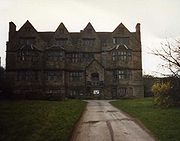
Weston, Staffordshire
Encyclopedia

Weston is a village situated 5 miles east of the county town of Stafford
Stafford
Stafford is the county town of Staffordshire, in the West Midlands region of England. It lies approximately north of Wolverhampton and south of Stoke-on-Trent, adjacent to the M6 motorway Junction 13 to Junction 14...
en route to the market town of Uttoxeter
Uttoxeter
Uttoxeter is a historic market town in Staffordshire, in the West Midlands region of England. The current population is approximately 13,711, though new developments in the town will increase this figure. Uttoxeter lies close to the River Dove and is near the cities of Stoke-on-Trent, Derby and...
. The village of Gayton
Gayton, Staffordshire
Gayton is a small rural village in Staffordshire, located approximately 1 mile from the A51 between Stone and Stafford. It has about 180 residents, with 1...
is approximately one mile to the east. Weston was formerly a small farming community. It has now grown to a population of some 1500 people (including Gayton), many of whom commute to work in the local towns.
History
Originally, the village of Weston was a forest clearing on the outskirts of the Chartley Estate. The high ground meant that the surrounding land was well drained with a good water supply from the nearby River TrentRiver Trent
The River Trent is one of the major rivers of England. Its source is in Staffordshire on the southern edge of Biddulph Moor. It flows through the Midlands until it joins the River Ouse at Trent Falls to form the Humber Estuary, which empties into the North Sea below Hull and Immingham.The Trent...
. This small settlement was also located at the intersection of the London - Lichfield - Chester road and the Shrewsbury - Stafford - Derby road (the current A51 and A518 respectively). The road from Stafford originally forded the Trent. In the late 18th Century a flood washed away the bridge there. It was later replaced by a single arch stone bridge in the 19th century.
Weston is an ancient parish. It originally formed part of the great Ferrers Estate of Chartley which was sold off in 1904.
The Parish Church of St. Andrews was restored by George Gilbert Scott
George Gilbert Scott
Sir George Gilbert Scott was an English architect of the Victorian Age, chiefly associated with the design, building and renovation of churches, cathedrals and workhouses...
in the 1860s and by William Butterfield
William Butterfield
William Butterfield was a Gothic Revival architect and associated with the Oxford Movement . He is noted for his use of polychromy-Biography:...
in the 1870s. Butterfield's restoration revealed some of the original Norman work. The bell tower dates from the early 13th Century. The tower holds two bells; "Ave Maria" dating from 1402 and "Ann Shaw" dating from 1962. A third bell, "Katerina", dating from 1500, can be found cracked upon the floor. The church also houses a silver communion paten dating from the early 15th Century. The Parish registers, kept by Staffordshire Record Office, date from 1581.
In the village, the present thatched "Manor House", which has been used as a farm building in the past, dates from the 16th Century. In the mid 19th Century it was used as the national School and school keeper's cottage, then as a Wesleyan Methodist
Methodist Church of Great Britain
The Methodist Church of Great Britain is the largest Wesleyan Methodist body in the United Kingdom, with congregations across Great Britain . It is the United Kingdom's fourth largest Christian denomination, with around 300,000 members and 6,000 churches...
meeting house until the present Methodist Church was built at the start of the 20th Century along the main London - Chester road.

